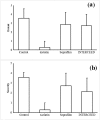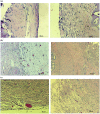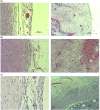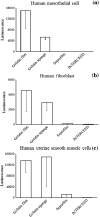Anti-adhesive effects of a newly developed two-layered gelatin sheet in dogs
- PMID: 28557204
- PMCID: PMC5575481
- DOI: 10.1111/jog.13358
Anti-adhesive effects of a newly developed two-layered gelatin sheet in dogs
Abstract
Aim: Adhesion after pelvic surgery causes infertility, ectopic pregnancy, and ileus or abdominal pain. The materials currently available for clinical use are insufficient. The purpose of this study was to develop an anti-adhesive material that overcomes the limitations of conventional anti-adhesive agents.
Methods: The adhesion prevention effects of three methods - a two-layered sheet composed of gelatin film and gelatin sponge, Seprafilm and INTERCEED - were evaluated in 37 dogs. Anti-adhesive effects were investigated macroscopically and microscopically in a cauterized uterus adhesion model. Cell growth on the materials in vitro using human peritoneal mesothelial cells, fibroblasts and uterine smooth muscle cells were also evaluated.
Results: The two-layered gelatin sheet had significantly superior anti-adhesive effects compared to the conventional materials (Seprafilm and INTERCEED). A single-cell layer of mature mesothelium formed three weeks after surgery in the gelatin group. Peritoneum regeneration in the Seprafilm and INTERCEED groups was delayed and incomplete in the early phase. Little inflammation around the materials occurred and cell growth was significantly proliferated with the gelatin sheet.
Conclusion: The anti-adhesive effects of a two-layered gelatin sheet were superior to conventional agents in a cauterized canine uterus model, demonstrating early regeneration of the peritoneum, little inflammation and material endurance. The newly developed two-layered gelatin sheet is a useful option as an anti-adhesive agent for deeply injured and hemorrhagic sites.
Keywords: adhesion; animal experiment; anti-adhesive agent; dog; two-layered gelatin sheet.
© 2017 The Authors. Journal of Obstetrics and Gynaecology Research published by John Wiley & Sons Australia, Ltd on behalf of Japan Society of Obstetrics and Gynecology.
Figures




Similar articles
-
Adhesion prevention in gynaecological surgery.J Obstet Gynaecol Can. 2010 Jun;32(6):598-602. doi: 10.1016/S1701-2163(16)34530-3. J Obstet Gynaecol Can. 2010. PMID: 20569542 English, French.
-
Efficacy of anti-adhesive barriers in secondary thyroidectomy: an experimental study.Laryngoscope. 2004 Sep;114(9):1668-73. doi: 10.1097/00005537-200409000-00031. Laryngoscope. 2004. PMID: 15475802
-
Development of gelatin flakes, a new type of anti-adhesive material: a preliminary study of in vivo rat adhesion models.Surg Today. 2014 Feb;44(2):391-4. doi: 10.1007/s00595-013-0608-3. Epub 2013 May 9. Surg Today. 2014. PMID: 23657645
-
Management and prevention of pelvic adhesions.Semin Reprod Med. 2011 Mar;29(2):130-7. doi: 10.1055/s-0031-1272475. Epub 2011 Mar 24. Semin Reprod Med. 2011. PMID: 21437827 Review.
-
Adhesions: pathogenesis and prevention-panel discussion and summary.Eur J Surg Suppl. 1997;(577):56-62. Eur J Surg Suppl. 1997. PMID: 9076453 Review.
Cited by
-
Prevention of Post-Operative Adhesions: A Comprehensive Review of Present and Emerging Strategies.Biomolecules. 2021 Jul 14;11(7):1027. doi: 10.3390/biom11071027. Biomolecules. 2021. PMID: 34356652 Free PMC article. Review.
-
Biomaterials to Prevent Post-Operative Adhesion.Materials (Basel). 2020 Jul 8;13(14):3056. doi: 10.3390/ma13143056. Materials (Basel). 2020. PMID: 32650529 Free PMC article. Review.
References
-
- Ward BC, Panitch A. Abdominal adhesions: Current and novel therapies. J Surg Res 2011; 165: 91–111. - PubMed
-
- Schnüriger B, Barmparas G, Branco BC, Lustenberger T, Inaba K, Demetriades D. Prevention of postoperative peritoneal adhesions: A review of the literature. Am J Surg 2011; 201: 111–121. - PubMed
-
- Kamel RM. Prevention of postoperative peritoneal adhesions. Eur J Obstet Gynecol Reprod Biol 2010; 150: 111–118. - PubMed
-
- Ray NF, Denton WG, Thamer M, Henderson SC, Perry S. Abdominal adhesiolysis: Inpatient care and expenditures in the United States in 1994. J Am Coll Surg 1998; 186: 1–9. - PubMed
Publication types
MeSH terms
Substances
LinkOut - more resources
Full Text Sources
Other Literature Sources
Medical

